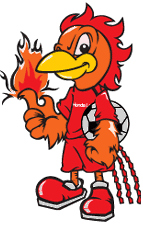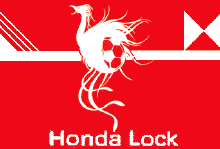Honda Lock
Team Results: 2005-present
|
The Honda Lock Kuroshio Soccer Group, as it was originally known, was established in 1964 as part of the social programme for the staff of the company making, yes, locks and keys for the Honda car and motorbike conglomerate in the city of Miyazaki, towards the southern end of Kyushu. Moving through the Miyazaki City and Prefectural Leagues - of which they were winners on eleven occasions - the club dallied unsuccessfully with the Kyushu League in the mid-80s, but eventually achieved a more permanent promotion in 1996. Adopting the name Honda Lock SC to go with their new status, 1997 saw the team nevertheless again struggling to cope with Regional level football early on in the year, but they recovered to finish in a respectable mid-table position. Over the next few seasons, Lock performed solidly if unspectacularly in the Kyushu League, their most successful time coming in 2000 when they finished second, a year after the club had received a boost via the putting into place of a more formalised relationship with their parent company. The club's 2004 campaign therefore came something out of the blue, when heading in to the last round of the season, they were still neck and neck at the top with hot favourites Okinawa Kariyushi, coached at that time by the legendary figure of Ruy Ramos. As is the Kyushu League's habit, the final two rounds of league fixtures were all held in one city over a weekend and Honda Lock's 10am kick-off in Kumamoto gave them a head start: they duly destroyed bottom club Osumi NIFS United 5-1. Kariyushi, meanwhile, had to stew until the afternoon and in a far tougher encounter went down to a disastrous 2-0 defeat at the hands of third place Volca Kagoshima. Honda Lock were Kyushu League champions. In the subsequent Annual Nationwide Regional League Championship Tournament, the team brushed aside Kanazawa SC and Norbritz Hokkaido in the first round, putting Honda Lock just a step away from a place in the highest non-professional football league in Japan, at the first attempt! The club faced off against Mitsubishi Mizushima from Okayama prefecture, Ryutsu Keizai University from Ibaraki and Saitama's Luminozo Sayama in the final round robin group, with the top two teams scheduled to win promotion. Following 2-2 draws against RKU and Luminozo in the opening two contests, Honda Lock with it all to play for against Mizushima, but in a desperately tight match they lost 1-0 to finish third in the group. Mizushima and RKU were automatically promoted, and that seemed to be that. A matter of days later, however, it was sensationally confirmed that the Kokushikan University club were to be expelled from the league as the result of a scandal involving impropriety by a group of their players - and Honda Lock thus found themselves entering the JFL by the back door. |
Honda Lock's first JFL campaign began with a dream fixture: away at Honda FC, the parent company's parent company, as it were. However, a 3-1 defeat made it clear that Lock would have a difficult time holding their own in the JFL. They gathered just fifteen points from the season and finished in 17th place, above only Mitsubishi Mizushima. The club clearly paid the price for not making any improvements to the squad that had gained promotion from the Kyushu League. The 2006 season was no more successful, and Honda Lock were unable to escape a drop back into the Kyu League in 2007.
The team remained competitive relative to most Kyu League opponents, but over the next several years, the large number of J.League wannabes rising into the JFL made it tough for a team that is dedicated to maintaining an amateur identity. Although the size of the parent company offers Honda Lock a solid base of players and the organizational strength to remain competitive, in the environment that prevailed between 2006 and 2013, that was not enough to ensure a fully amateur team of a firm spot in the JFL. With so many teams ambitiously chasing promotion to the J.League, a company club like Honda Lock was at a clear disadvantage. Though they did rebound and managed to climb back into the JFL at the end of the 2008 season, the next few years would mark the critical stage of the conflict between true amateurs and teams that were professional in all but name.
There has been some discussion about Honda Lock converting to a professional structure themselves. Miyazaki prefecture does not yet have a candidate for J.League participation. However, as Kyushu's least populous prefecture, Miyazaki may not have a particularly large grassroots base to build on. It seems conceivable that the area could support a small pro club, but it would be up to Honda Lock to spin off the club from its corporate roots and give it an independent management structure. As a member of the Honda group, Lock seems more inclined to continue fighting to keep the spirit of amateur competition alive.
Fortunately, the reorganization of the JFL (and the creation of a J3) in 2014 returned control of the JFL to proponents of the amateur game. Under the new structure, hopefully the conflict between true amateurs and teams that are pursuing a professional future will not be as severe as it was in the past. For now, at least, it seems that Honda Lock will remain loyal to the amateur concept.




